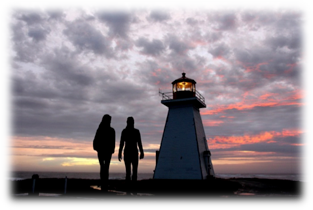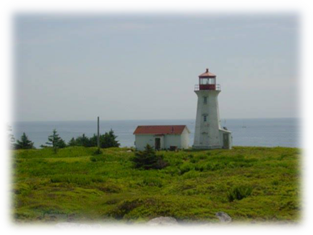Visit Lighthouses
Since 1788, our lighthouses have played an important part in marine navigation for the hundreds of fishermen and mariners who sail our Atlantic waters.
Today our lighthouses serve as symbols of our seafaring heritage. While we can observe from many scenic coastal vantage points throughout the County, we must remember that many of the lights were put out to sea to guide boaters and therefore are only accessible by boat.
Each light has its own unique ocean view, whether it has the mighty Atlantic waves crashing on its shores, hidden in a quiet bay or has a beautiful white sand beach surrounding it. Hike, bird watch, geocache or just relax and take in the breathtaking vistas.
Download information about pdf Lobster Tales Lighthouse Trail(4.14 MB) .
BACCARO POINT LIGHTHOUSE – Baccaro, NS

Perched at the edge of the ocean, this lighthouse is an important seabird watching site.
Located on the east side of Barrington Bay near Port La Tour, this small wooden lighthouse was built in 1934. It replaced the original building, built in 1850, which was destroyed by fire.
Baccaro is the oldest place name in Nova Scotia. It comes from the Basque word, Baccolaos, cod-fish. Baccaro point is the most southerly point of mainland Nova Scotia. (Cape Sable, off Cape Sable Island, is the furthest south.) In 1852 the materials for the first lighthouse were hauled along the beach – there being no road. Today the tall (45 feet), square tapered building stands fast on its bed of solid rock.
Accessible on land.
43°26'59''N 65°28'15''W
BON PORTAGE – Shag Harbour, NS

The Bon Portage Island lighthouse was established in 1874. For 110 years, 16 principal lightkeepers and their families kept the light burning on this small, windswept island. The longest-serving keeper was Morrill Richardson, who along with his wife Evelyn, bought the island (except for the lighthouse property) in 1929.
In 1945, Evelyn Richardson’s classic book We Keep A Light was published and quickly became a best-seller in Canada. She described her family’s life on the island with sensitivity and humour, noting both the disadvantages and joys of life on an isolated island.
Bon Portage Lighthouse was replaced in 1964 by the current building.
Accessible only by boat.
43°27'23.2''N 65°44'36.2''W
CAPE NEGRO ISLAND LIGHTHOUSE – Cape Negro, NS

Located on the Southeastern end of the island, this structure is 91 feet tall with a light range of 16 miles. Originally built in 1872, the current tower was replaced in 1915 and was automated in 1993. Cape Negro was named on Champlain’s map of 1612. In his book The Works of Samuel de Champlain, Volume 1, Champlain wrote “Proceeding along the coast we reached a very good port for vessels, and the head of which is a little river extending a good way inland. I named this the harbour of Cape Negro, on account of a rock which from a distance looks like one…"
43°30'26.2''N 65°20'44.2''W
CAPE SABLE LIGHTHOUSE – Cape Sable, NS

Built in 1861, the Cape Sable Lighthouse is the tallest lighthouse in Nova Scotia, standing at 101 feet tall. The station was destaffed in 1986. Although it is only accessible by boat, a magnificent view can be seen from the beach at the end of The Hawk Road, located on Cape Sable Island. The light is not open to the public but can be explored out and around it. This area is also designated as an Important Bird Area.
On July 28, 1989, the Federal Heritage Building Review Office designated the Cape Sable Light tower a Classified Building, providing it with the highest level of ongoing protection.
43°23'24''N 65°37'16.9''W
CHARLESVILLE (PUBNICO HARBOUR) LIGHTHOUSE – Charlesville, NS

The original Charlesville (Pubnico Harbour) Lighthouse was built in 1854. It was a white, square, pyramidal wooden tower with a red lantern, with a dwelling attached. Both were demolished in 1967 and replaced with a conical fibreglass tower. Accessible on land. Great spot for viewing the Pubnico Wind Farms and fishing boats in Pubnico Harbour.
43°35'53.4''N 65°46'55.6''W
SEAL ISLAND LIGHTHOUSE MUSEUM – Barrington, NSM

The museum, a replica of the top half of the Seal Island Lighthouse, displays lighthouse equipment and memorabilia and tells the fascinating history of the lights and area’s light keeping families on Cape Sable Island, Bon Portage, and Seal Island, as well as the hundreds of shipwrecks that made Seal Island a Bay of Fundy graveyard in the days of wooden sailing ships. The building is topped by the cast iron lantern which was removed from the tower on Seal Island in 1978.
From the third level, you can climb the iron stairs as the keepers did for 76 years and see the original clockwork mechanism and the only installed Fresnel lens in Nova Scotia. From the top, you can take in the spectacular view of Barrington Bay.
Season – June – September
43°33'50''N 65°33'53''W
STODDARD ISLAND (EMERALD ISLE) LIGHTHOUSE – Shag Harbour, NS

Located in Shag Harbour, NS, this square, the wooden tower was built in 1877. Standing at 21 feet tall the station was destaffed in 1993.
43°28'24''N 65°43'06''W
THE SALVAGES – Cape Negro, NS

The Salvages is a group of ledges and rocks on the west side of Cape Negro Harbour. In 1915 a diaphone was placed on the highest rock which gave three blasts every minute to warn seafarers. In 1965 a white rectangular lighthouse was built standing at 53 feet high. On a clear day the station can be seen from Baccaro Point.
43°28'08.1''N 65°22'44''W
WEST HEAD LIGHTHOUSE – West Head, Cape Sable Island

Established in 1888, this lighthouse was built on the west side of Cape Sable Island. Replaced in the 1970s, this 51-foot tower can be seen from afar. It was automated in 1993.
43°27'23.8''N 65°39'16.9''W
WOOD’S HARBOUR LIGHTHOUSE – Wood’s Harbour, NS

Built on a rock ledge of Cockawit Passage, the wooden lighthouse was built in 1900. It was replaced in 1965 and then destaffed in 1993.
43°35'53.4''N 65°46'55.6''W
NOTE: Some lighthouses have loud automated fog horns, which can be active at any time (even in the sunshine!). Never walk directly in front of the fog horn emitters, as hearing damage may result. Please obey all warning signs and beware of dangers on cliffs and rocks, as well as tides.
